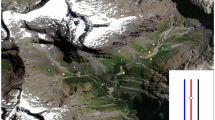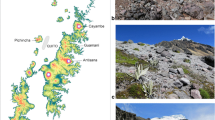Abstract
This study determined a millipede sampling protocol that was efficient, replicable, and thorough, by testing commonly used methods (pitfall trapping, hand collection, and leaf litter collection with Berlese extraction) at sites where the fauna had been intensively sampled, so that the results of different sampling protocols (‘experimental sampling’) could be compared to the previously known fauna of each site (determined by ‘baseline sampling’). Two methods of collecting leaf litter were compared. One method allowed the collector to choose the locations from which to sample leaf litter, while the second method used randomly generated locations. Experimental sampling took place at both an upland site (Swallow Cliff Woods, Cook Co, IL) and a wetland site (Cedarburg Bog, Ozaukee Co, WI) where reliable baseline data was available. The optimal protocol for millipedes was found to consist of a combination of the hand collection and the a priori litter methods. In studies where there are constraints on time or resources devoted to sampling or processing, this protocol can be reduced to the single most effective method, hand collection. Overall, the a priori litter collection method was more effective than the random litter collection method.
Similar content being viewed by others
References
A.G. Appel (2003) ArticleTitleIPM of occasional urban invader pest species J. Entomol. Sci. 38 151–158
E. Branquart R.D. Kime M. Dufrene J. Tavernier G. Wauthy (1995) ArticleTitleMacroarthropod–habitat relationships in oak forests in South Belgium: 1. Environments and communities Pedobiologia 39 243–263
R.V. Chamberlin (1922) ArticleTitleFurther notes on the nomenclature of North American Julidae and Nemasomidae Proc. Biol. Soc. Washington 35 7–10
J.A. Coddington C.E. Griswold D.S. Dávila E. Peñaranda S.F. Larcher (1991) Designing and testing sampling protocols to estimate biodiversity in tropical ecosystems E.C. Dudley (Eds) The Unity of Evolutionary Biology: Proceedings of the Fourth International Congress of Systematic and Evolutionary Biology Dioscorides Press Portland, OR 45–60
Colwell R.K. 1997. EstimateS: Statistical Estimation of Species Richness and Shared Species from Samples. Version 5. User's Guide and Application Published at: http://viceroy.eeb. uconn.edu/estimates.
O.F. Cook (1911) ArticleTitleThe hothouse milliped as a new genus Proc. US National Museum 40 625–631
J.M. Dangerfield A.E. Milner (1996) ArticleTitleMillipede fecal pellet production in selected natural and managed habitats of Southern Africa: implications for litter dynamics Biotropica 28 113–120 Occurrence Handle10.2307/2388776
H. Enghoff (1984) ArticleTitleA revision of the Nopoiulinae, with notes on the classification of Blaniulid millipedes (Diplopoda: Julida: Blaniulidae) Senckenbergiana Biol. 64 393–427
C. Grelle M.C. Fabre A. Leprêtre M. Descamps (2000) ArticleTitleMyriapod and isopod communities in soils contaminated by heavy metals in northern France Eur. J. Soil Sci. 51 425–433 Occurrence Handle1:CAS:528:DC%2BD3cXntFGjtrY%3D Occurrence Handle10.1046/j.1365-2389.2000.00317.x
M.L. Hamer R.H. Slotow (2002) ArticleTitleConservation application of existing data for South African millipedes (Diplopoda) African Entomol. 10 29–42
R.L. Hoffman (1962) ArticleTitleThe milliped genus Scytonotus in Eastern North Americawith the description of two new species Am. Midland Nat. 67 241–249 Occurrence Handle10.2307/2422832
R.L. Hoffman (1974) ArticleTitleA new polydesmid milliped from the southern Appalachians, with remarks on the status of Dixidesmusa proposed terminology for polydesmid gonopods Proc. Biol. Soc. Washington 87 345–350
Hoffman R.L. 1999. Checklist of the Millipedes of Middle and North America. Virginia Museum of Natural History Special Publication 8.
S.P. Hopkin H.J. Read (1992) The Biology of Millipedes Oxford University Press New York, NY
W.T. Keeton (1960) ArticleTitleA taxonomic study of the milliped family Spirobolidae (Diplopoda: Spirobolida) Memoirs Am. Entomol. Soc. 17 1–146
Marshall S.A., Anderson R.S., Roughley R.E., Behan-Pelletier V. and Danks H.V. 1994. Terrestrial arthropod biodiversity: planning a study and recommended sampling techniques. Bull. Entomol. Soc. Canada 26, supplement. 33 pp.
R. Mesibov R.J. Taylor R.N. Brereton (1995) ArticleTitleRelative efficiency of pitfall trapping and hand-collecting from plots for sampling of millipedes Biodivers. Conserv. 4 429–439 Occurrence Handle10.1007/BF00058426
J. Ozanova (2000) ArticleTitleMillipede community of the Hurka u Hranic NNR, Czech Republic (Diplopoda) Fragementa Faunistica Warsaw 43 IssueID(Supplement) 321–325
J.A. Reinartz (1985) ArticleTitleA guide to the natural history of the Cedarburg Bog. Part I The University of Wisconsin – Milwaukee Field Station Bull. 18 1–48
N. Scharff J.A. Coddington C.E. Griswold G. Hormiga P. Bjørn (2003) ArticleTitleWhen to quit? Estimating spider species richness in a northern European deciduous forest J. Arachnol. 31 246–273
W.A. Shear (1972) ArticleTitleStudies in the milliped order Chordeumida (Diplopoda): a revision of the family Cleidogonidae and a reclassification of the order Chordeumida in the new world Bull. Museum Comparative Zool. 144 151–352
R.M. Shelley (1984) ArticleTitleA synopsis of the milliped genus Abacion Rafinesque (Callipodida: Caspiopetalidae) Can. J. Zool. 62 980–988 Occurrence Handle10.1139/z84-137
R.M. Shelley (1998) ArticleTitleThe milliped family Polyzoniidae in North America, with a classification of the global fauna (Diplopoda: Polyzoniida) Arthropoda Selecta 6 3–34
R.M. Shelley (2002) ArticleTitleThe milliped genus Oriulus Chamberlin (Julida: Parajulidae) Can. J. Zool. 80 100–109 Occurrence Handle10.1139/z01-205
R.M. Shelley (2003) ArticleTitleA revised, annotated, family level classification of the Diplopoda Arthropoda Selecta 11 187–207
D. Sheskin (2000) Handbook of Parametric and Nonparametric Statistical Procedures Chapman & Hall/CRC Boca Raton, FL
A.M. Smit R.J. Van Aarde (2001) ArticleTitleThe influence of millipedes on selected soil elements: a microcosm study on three species occurring on coastal sand dunes Functional Ecol. 15 51–59 Occurrence Handle10.1046/j.1365-2435.2001.00493.x
B.A. Snyder M.L. Draney J.L. Kaspar J. Whitehouse (2004) ArticleTitlePreliminary survey of the terrestrial isopods (Isopoda), millipedes (Diplopoda), harvestmen (Opiliones), and spiders (Araneae) of Toft Point Natural AreaDoor County, Wisconsin Great Lakes Entomol. 37 105–115
K. Tajovsky (2000) ArticleTitleMillipede succession in abandoned fields Fragementa Faunistica Warsaw 43 IssueID(Supplement) 361–370
G.W. Uetz J.D. Unzicker (1976) ArticleTitlePitfall trapping in ecological studies of wandering spiders J. Arachnol. 3 101–111
Watermolen D.J. 1995. Wisconsin Millipedes: A Preliminary Species List and a Catalog of Records. Wisconsin Entomological Society Special Publication No. 3.
Wisconsin Department of Natural Resources. 2003. Cedarburg Bog, State Natural Area (No.2) Website. Url: http://www.dnr.state.wi.us/org/land/er/sna/sna2.htm.
Author information
Authors and Affiliations
Corresponding author
Rights and permissions
About this article
Cite this article
Snyder, B.A., Draney, M.L. & Sierwald, P. Development of an optimal sampling protocol for millipedes (Diplopoda). J Insect Conserv 10, 277–288 (2006). https://doi.org/10.1007/s10841-006-6699-z
Received:
Accepted:
Issue Date:
DOI: https://doi.org/10.1007/s10841-006-6699-z




